Why we love pass4itsure 70-461 exam dumps (And you should, too!)? Pass4itsure Microsoft 70-461 dumps exam (Querying Microsoft SQL Server 2012) offers free PDF demo to download. Best quality Microsoft 70-461 dumps practice test Querying Microsoft SQL Server 2012 with latest version video study. With the complete collection of questions and answers, pass4itsure has assembled to take you through 164 Q&As to your 70-461 exam preparation. Using pass4itsure’s qualified expert https://www.pass4itsure.com/70-461.html dumps products you are able to correctly solution the actual training questions with ease. This certificate proves that the candidate has an advanced understanding within the SQL Server database administrators, system engineers, and developers with two or more years of experience, who are seeking to validate their skills and knowledge in writing queries.

Free VCE & PDF File for Microsoft 70-461 Real Exam Quetsions(1-12)
QUESTION 1
You administer a Microsoft SQL Server 2012 database. The database contains a table named Employee. Part of the Employee table is shown in the exhibit. (Click the Exhibit button.)

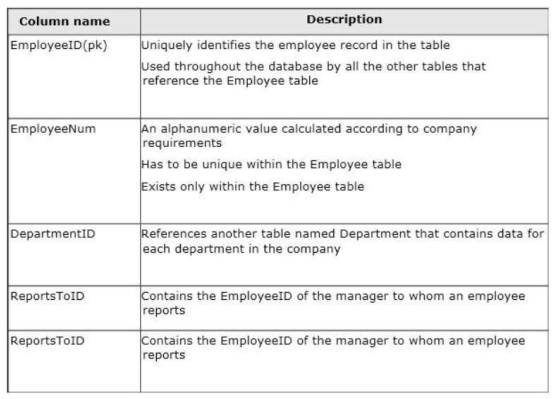
Confidential information about the employees is stored in a separate table named EmployeeData. One record exists within EmployeeData for each record in the Employee table. You need to assign the appropriate constraints and table properties to ensure data integrity and visibility. On which column in the Employee table should you create a unique constraint?
A. DateHired
B. DepartmentID
C. EmployeeID
D. EmployeeNum
E. FirstName
F. JobTitle
G. LastName
H. MiddleName
I. ReportsToID
70-461 exam Correct Answer: D
QUESTION 2
You administer a Microsoft SQL Server 2012 database named ContosoDb. Tables are defined as shown in the exhibit. (Click the Exhibit button.)

You need to display rows from the Orders table for the Customers row having the CustomerId value set to 1 in the following XML format:
<row OrderId=”1″ OrderDate=”2000-01-01T00:00:00″ Amount=”3400.00″ Name=”Customer A”
Country=”Australia” /> <row OrderId=”2″ OrderDate=”2001-01-01T00:00:00″ Amount=”4300.00″
Name=”Customer A” Country=”Australia” />
Which Transact-SQL query should you use?
A. SELECT OrderId, OrderDate, Amount, Name, Country
FROM Orders INNER JOIN Customers ON Orders.CustomerId = Customers.CustomerId
WHERE Customers.CustomerId = 1
FOR XML RAW
B. SELECT OrderId, OrderDate, Amount, Name, Country
FROM Orders INNER JOIN Customers ON Orders.CustomerId = Customers.CustomerId
WHERE Customers.CustomerId = 1
FOR XML RAW, ELEMENTS
C. SELECT OrderId, OrderDate, Amount, Name, Country
FROM Orders INNER JOIN Customers ON Orders.CustomerId = Customers.CustomerId
WHERE Customers.CustomerId = 1
FOR XML AUTO
D. SELECT OrderId, OrderDate, Amount, Name, Country
FROM Orders INNER JOIN Customers ON Orders.CustomerId – Customers.CustomerId
WHERE Customers.CustomerId = 1
FOR XML AUTO, ELEMENTS
E. SELECT Name, Country, OrderId, OrderDate, Amount
FROM Orders INNER JOIN Customers ON Orders.CustomerId= Customers.CustomerId
WHERE Customers.CustomerId = 1
FOR XML AUTO
F. SELECT Name, Country, OrderId, OrderDate, Amount
FROM Orders INNER JOIN Customers ON Orders.CustomerId= Customers.CustomerId
WHERE Customers.CustomerId = 1
FOR XML AUTO, ELEMENTS
G. SELECT Name AS ‘@Name’, Country AS ‘@Country’, OrderId, OrderDate, Amount
FROM Orders INNER JOIN Customers ON Orders.CustomerId= Customers.CustomerId
WHERE Customers.CustomerId = 1
FOR XML PATH (‘Customers’)
H. SELECT Name AS ‘Customers/Name’, Country AS ‘Customers/Country’, OrderId,
OrderDate, Amount
FROM Orders INNER JOIN Customers ON Orders.CustomerId= Customers.CustomerId
WHERE Customers.CustomerId = 1
FOR XML PATH (‘Customers’)
Correct Answer: A
QUESTION 3
You use Microsoft SQL Server 2012 to develop a database application. Your application sends data to an NVARCHAR(MAX) variable named @var. You need to write a Transact-SQL statement that will find out the success of a cast to a decimal (36,9). Which code segment should you use?
A. BEGIN TRY
SELECT
convert (decimal(36,9), @var) as Value,
‘True’ As BadCast
END TRY
BEGIN CATCH
SELECT
convert (decimal(36,9), @var) as Value,
‘False’ As BadCast
END CATCH
B. TRY(
SELECT convert (decimal(36,9), @var)
SELECT ‘True’ As BadCast
)
CATCH(
SELECT ‘False’ As BadCast
)
C. SELECT
CASE
WHEN convert (decimal(36,9), @var) IS NULL
THEN ‘True’
ELSE ‘False’
END
AS BadCast
D. SELECT
IF(TRY_PARSE(@var AS decimal(36,9)) IS NULL,
‘True’,
‘False’
)
AS BadCast
70-461 dumps Correct Answer: D
QUESTION 4
You administer a Microsoft SQL Server 2012 database named ContosoDb. Tables are defined as shown in the exhibit. (Click the Exhibit button.)

You need to display rows from the Orders table for the Customers row having the CustomerId value set to 1 in the following XML format.
<CUSTOMERS Name=”Customer A” Country=”Australia”>
<ORDERS OrderID=”1″ OrderDate=”2001-01-01″ Amount=”3400.00″ />
<ORDERS OrderID=”2″ OrderDate=”2002-01-01″ Amount=”4300.00″ />
</CUSTOMERS>
Which Transact-SQL query should you use?
A. SELECT OrderId, OrderDate, Amount, Name, Country
FROM Orders INNER JOIN Customers ON Orders.CustomerId = Customers.CustomerId
WHERE Customers.CustomerId = 1
FOR XML RAW
B. SELECT OrderId, OrderDate, Amount, Name, Country
FROM Orders INNER JOIN Customers ON Orders.CustomerId = Customers.CustomerId
WHERE Customers.CustomerId = 1
FOR XML RAW, ELEMENTS
C. SELECT OrderId, OrderDate, Amount, Name, Country
FROM Orders INNER JOIN Customers ON Orders.CustomerId = Customers.CustomerId
WHERE Customers.CustomerId = 1
FOR XML AUTO
D. SELECT OrderId, OrderDate, Amount, Name, Country
FROM Orders INNER JOIN Customers ON Orders.CustomerId – Customers.CustomerId
WHERE Customers.CustomerId = 1
FOR XML AUTO, ELEMENTS
E. SELECT Name, Country, OrderId, OrderDate, Amount
FROM Orders INNER JOIN Customers ON Orders.CustomerId= Customers.CustomerId
WHERE Customers.CustomerId = 1
FOR XML AUTO
F. SELECT Name, Country, OrderId, OrderDate, Amount
FROM Orders INNER JOIN Customers ON Orders.CustomerId= Customers.CustomerId
WHERE Customers.CustomerId = 1
FOR XML AUTO, ELEMENTS
G. SELECT Name AS ‘@Name’, Country AS ‘@Country’, OrderId, OrderDate, Amount
FROM Orders INNER JOIN Customers ON Orders.CustomerId= Customers.CustomerId
WHERE Customers.CustomerId = 1
FOR XML PATH (‘Customers’)
H. SELECT Name AS ‘Customers/Name’, Country AS ‘Customers/Country’, OrderId, OrderDate, Amount
FROM Orders INNER JOIN Customers ON Orders.CustomerId= Customers.CustomerId
WHERE Customers.CustomerId = 1
FOR XML PATH (‘Customers’)
Correct Answer: E
QUESTION 5
You are a database developer of a Microsoft SQL Server 2012 database. The database contains a table named Customers that has the following definition:

You need to ensure that the CustomerId column in the Orders table contains only values that exist in the CustomerId column of the Customer table. Which Transact-SQL statement should you use?
A. ALTER TABLE Orders
ADD CONSTRAINT FX_Orders_CustomerID FOREIGN KEY (CustomerId) REFERENCES
Customer (CustomerId)
B. ALTER TABLE Customer
ADD CONSTRAINT FK_Customer_CustomerID FOREIGN KEY {CustomerID) REFERENCES
Orders (CustomerId)
C. ALTER TABLE Orders
ADD CONSTRAINT CK_Orders_CustomerID
CHECK (CustomerId IN (SELECT CustomerId FROM Customer))
D. ALTER TABLE Customer
ADD OrderId INT NOT NULL;
ALTER TABLE Customer
ADD CONSTRAINT FK_Customer_OrderID FOREIGN KEY (OrderID) REFERENCES Orders
(OrderID);
E. ALTER TABLE Orders
ADD CONSTRAINT PK Orders CustomerId PRIMARY KEY (CustomerID)
70-461 pdf Correct Answer: A
QUESTION 6
You administer a Microsoft SQL Server 2012 database named ContosoDb. Tables are defined as shown in the exhibit. (Click the Exhibit button.)

You need to display rows from the Orders table for the Customers row having the CustomerId value set to 1 in the following XML format.
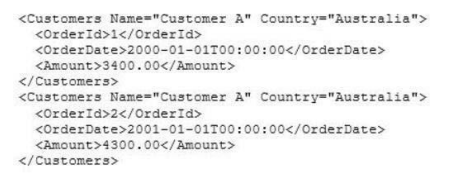
Which Transact-SQL query should you use?
A. SELECT OrderId, OrderDate, Amount, Name, Country FROM Orders
INNER JOIN Customers ON Orders.CustomerId = Customers.CustomerId
WHERE Customers.CustomerId = 1
FOR XML RAW
B. SELECT OrderId, OrderDate, Amount, Name, Country FROM Orders
INNER JOIN Customers ON Orders.CustomerId = Customers.CustomerId
WHERE Customers.CustomerId = 1
FOR XML RAW, ELEMENTS
C. SELECT OrderId, OrderDate, Amount, Name, Country FROM Orders
INNER JOIN Customers ON Orders.CustomerId = Customers.CustomerId
WHERE Customers.CustomerId = 1
FOR XML AUTO
D. SELECT OrderId, OrderDate, Amount, Name, Country FROM Orders
INNER JOIN Customers ON Orders.CustomerId – Customers.CustomerId
WHERE Customers.CustomerId = 1
FOR XML AUTO, ELEMENTS
E. SELECT Name, Country, OrderId, OrderDate, Amount FROM Orders
INNER JOIN Customers ON Orders.CustomerId = Customers.CustomerId
WHERE Customers.CustomerId = 1
FOR XML AUTO
F. SELECT Name, Country, OrderId, OrderDate, Amount FROM Orders
INNER JOIN Customers ON Orders.CustomerId = Customers.CustomerId
WHERE Customers.CustomerId = 1
FOR XML AUTO, ELEMENTS
G. SELECT Name AS ‘@Name’, Country AS ‘@Country’, OrderId, OrderDate, Amount FROM
Orders
INNER JOIN Customers ON Orders.CustomerId = Customers.CustomerId
WHERE Customers.CustomerId = 1
FOR XML PATH (‘Customers’)
H. SELECT Name AS ‘Customers/Name’, Country AS ‘Customers/Country’, OrderId,
OrderDate, Amount FROM Orders
INNER JOIN Customers ON Orders.CustomerId = Customers.CustomerId
WHERE Customers.CustomerId = 1
FOR XML PATH (‘Customers’)
Correct Answer: G
QUESTION 7
You administer a Microsoft SQL Server 2012 database that has Trustworthy set to On. You create a stored procedure that returns database-level information from Dynamic Management Views. You grant User1 access to execute the stored procedure. You need to ensure that the stored procedure returns the required information when User1 executes the stored procedure. You need to achieve this goal by granting the minimum permissions required. What should you do? (Each correct answer presents a complete solution. Choose all that apply.)
A. Create a SQL Server login that has VIEW SERVER STATE permissions. Create an application role and a secured password for the role.
B. Modify the stored procedure to include the EXECUTE AS OWNER statement. Grant VIEW SERVER STATE permissions to the owner of the stored procedure.
C. Create a SQL Server login that has VIEW SERVER STATE permissions. Modify the stored procedure to include the EXECUTE AS {newlogin} statement.
D. Grant the db_owner role on the database to User1.
E. Grant the sysadmin role on the database to User1.
70-461 vce Correct Answer: DE
QUESTION 8
You administer a Microsoft SQL Server database named Sales. The database is 3 terabytes in size. The Sales database is configured as shown in the following table.

You discover that Sales_2.ndf is corrupt. You need to recover the corrupted data in the minimum amount of time. What should you do?
A. Perform a file restore.
B. Perform a transaction log restore.
C. Perform a restore from a full backup.
D. Perform a filegroup restore.
Correct Answer: A
QUESTION 9
You are developing a database that will contain price information. You need to store the prices that include a fixed precision and a scale of six digits. Which data type should you use?
A. Real
B. Small money
C. Money
D. Decimal
70-461 exam Correct Answer: D
QUESTION 10
You administer a Microsoft SQL Server 2012 database. The database contains a table named Employee. Part of the Employee table is shown in the exhibit. (Click the Exhibit button.)
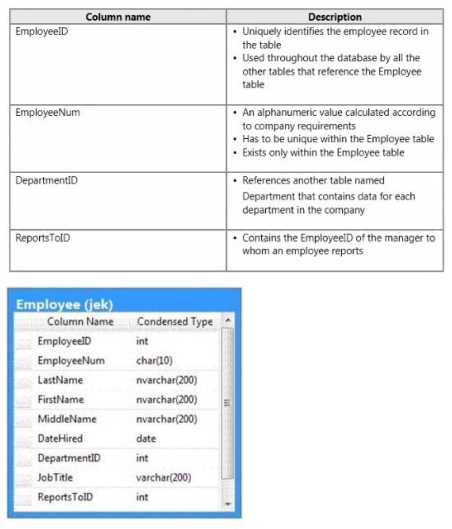
Unless stated above, no columns in the Employee table reference other tables. Confidential information about the employees is stored in a separate table named EmployeeData. One record exists within EmployeeData for each record in the Employee table. You need to assign the appropriate constraints and table properties to ensure data integrity and visibility. On which column in the Employee table should you create a Foreign Key constraint that references a different table in the database?
A. DateHired
B. DepartmentID
C. EmployeeID
D. EmployeeNum
E. FirstName
F. JobTitle
G. LastName
H. MiddleName
I. ReportsToID
Correct Answer: C
QUESTION 11
You administer a Microsoft SQL Server 2012 database. The database contains a table named Employee. Part of the Employee table is shown in the exhibit. (Click the Exhibit button.)

Unless stated above, no columns in the Employee table reference other tables. Confidential information about the employees is stored in a separate table named EmployeeData. One record exists within EmployeeData for each record in the Employee table. You need to assign the appropriate constraints and table properties to ensure data integrity and visibility. On which column in the Employee table should you create a Primary Key constraint for this table?
A. DateHired
B. DepartmentID
C. EmployeeID
D. EmployeeNum
E. FirstName
F. JobTitle
G. LastName
H. MiddleName
I. ReportsToID
70-461 dumps Correct Answer: C
QUESTION 12
You are a database developer for an application hosted on a Microsoft SQL Server 2012 server. The database contains two tables that have the following definitions:

Global customers place orders from several countries. You need to view the country from which each customer has placed the most orders. Which Transact-SQL query do you use?
A. SELECT CustomerID, CustomerName, ShippingCountry
FROM
(SELECT c.CustomerID, c.CustomerName, o.ShippingCountry,
RANK() OVER (PARTITION BY c.CustomerID
ORDER BY COUNT(o.OrderAmount) ASC) AS Rnk
FROM Customer c
INNER JOIN Orders o
ON c.CustomerID = o.CustomerID
GROUP BY c.CustomerID, c.CustomerName,
B. ShippingCountry) cs
WHERE Rnk = 1
C. SELECT c.CustomerID, c.CustomerName, o.ShippingCountry
FROM Customer c
INNER JOIN
(SELECT CustomerID, ShippingCountry,
COUNT(OrderAmount) AS OrderAmount
FROM Orders
GROUP BY CustomerID, ShippingCountry) AS o
ON c.CustomerID = o.CustomerID
ORDER BY OrderAmount DESC
D. SELECT CustomerID, CustomerName, ShippingCountry
FROM
(SELECT c.CustomerID, c.CustomerName,
E. ShippingCountry,
RANK() OVER (PARTITION BY c. CustomerID
ORDER BY o. OrderAmount DESC) AS Rnk
FROM Customer c
INNER JOIN Orders o
ON c.CustomerID = o.CustomerID
GROUP BY c.CustomerID, c.CustomerName,
F. ShippingCountry) cs
WHERE Rnk = 1
G. SELECT c.CustomerID, c.CustomerName, o.ShippingCountry
FROM Customer c
INNER JOIN
(SELECT CustomerID, ShippingCountry,
RANK() OVER (PARTITION BY CustomerID
ORDER BY COUNT(OrderAmount) DESC) AS Rnk
FROM Orders
GROUP BY CustomerID, ShippingCountry) AS o
ON c.CustomerID = o.CustomerID
Where o.Rnk = 1
Correct Answer: C
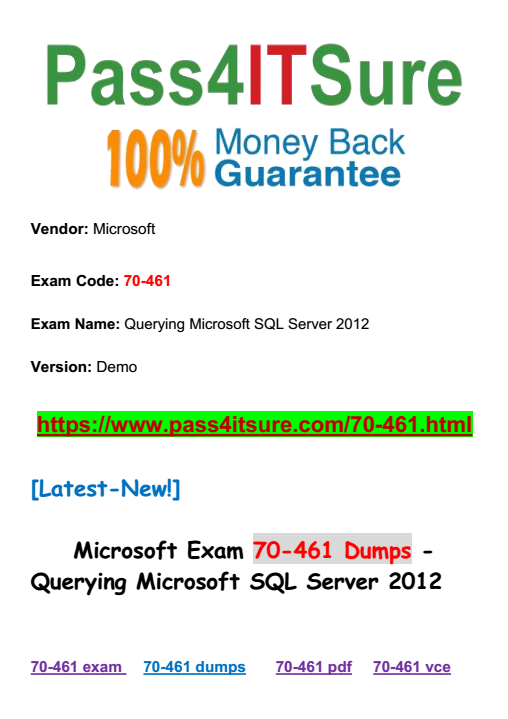
[New Updated Spring 2018 Microsoft 70-461 Dumps Updated From Google Drive]:https://drive.google.com/open?id=1rmpVGNHD7aLfDdgQ_y-jrvXbPeliXoT5
[New Updated Spring 2018 Microsoft 70-483 Dumps Updated From Google Drive]:https://drive.google.com/open?id=1g4Vd4ELbqqdZk5P9lIpEVPx4Qzxz1QIl
70-461 dumps (Querying Microsoft SQL Server 2012) is the part of Microsoft (MCP, MCSA, MCSE) certification. Well-equipped and also practical MCTS certification 70-461 test, pass4itsures Storage space tend to be total plausible 70-461 simulator concerns. Pass4itsure has a team of Microsoft experts to develop the best https://www.pass4itsure.com/70-461.html dumps exam products, which covers all the knowledge points of the real Microsoft exam. Pass4itsure Microsoft 70-461 dumps exam questions answers are updated (91 Q&As) are verified by experts.
See What Our Customers Are Saying:
We at Pass4itsure are committed to our customer’s success. Our Microsoft 70-461 dumps are created with utmost care and professionalism. With pass4itsure, you understand just about all learning knowledge to pass through your 70-461 test.
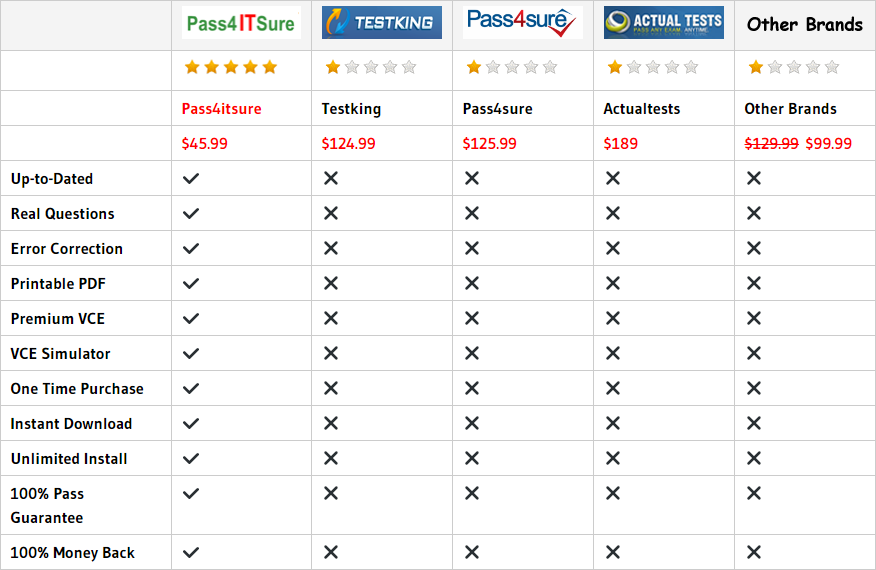
Certified Professional 70-461 dumps test questions are designed from your core to obtain by way of the most difficult versions. Compared with other brands, Pass4itsure has up to dated exam information, affordable price, instant exam PDF files downloaded, error correction, unlimited install,etc. Such as Pass4itsure Microsoft 70-461 Dumps Guide Provider, Best Quality Microsoft 70-461 Dumps Practice Latest Version PDF&VCE, We Help You Pass Querying Microsoft SQL Server 2012.